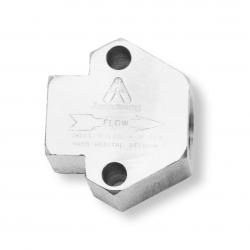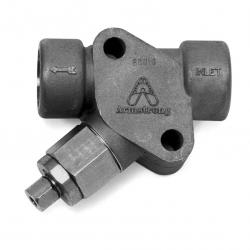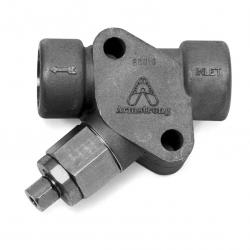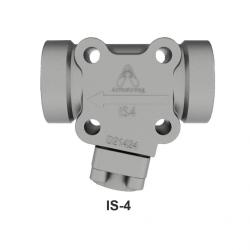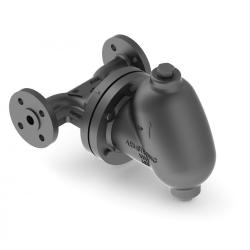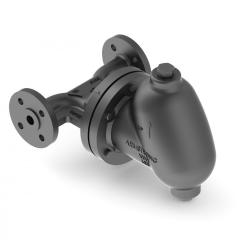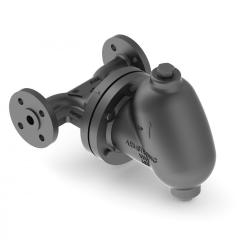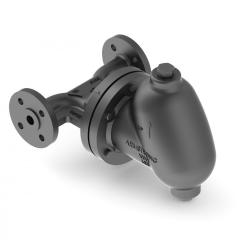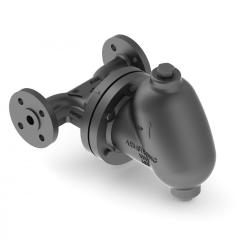Float and Thermostatic Traps (F&T)
Steam and Filter Products
View:
Active Filters :
- Main Category: Steam and Filter Products
- Steam Traps: Float and Thermostatic Traps (F&T) Trap Connector Blocks
- End Connection: Socket Weld
- Alt. Size: 3/4"
Part #:501-B2311D-2
- Steam Trap ConnectorsBesides 2000 Series stainless steel inverted bucket traps, the standard 360 connector or IS-2 connector with integral strainer can also be used on many Armstrong thermostatic, disc, bimetallic, and float and thermostatic traps. Any manufacturers two-bolt steam traps can use Armstrong connectors.
IS-2 Stainless Steel Connector with Integral Strainer
• A full line stainless steel strainer in the connector eliminates leak points and reduces installation time
• A strainer that is not discarded when the trap is replaced
• Easy strainer screen replacement
• Optional blowdown valve
• Accommodates Armstrongs inverted bucket, disc, thermostatic, thermostatic wafer, bimetallic, and float and thermostatic traps. Any manufacturers 2-bolt steam trap can also be applied to Armstrongs S-2 connector.
Standard 360 Stainless Steel Connector
• A compact, lightweight assembly
• Standardization, reducing inventory
• A compact design, simplifying piping
• Accommodates Armstrongs inverted bucket, disc, thermostatic, thermostatic wafer and bimetallic steam traps. Any manufacturers 2-bolt steam trap can also be applied to Armstrongs standard connector.
Qty:
Part #:501-D3448-6
- Steam Trap ConnectorsBesides 2000 Series stainless steel inverted bucket traps, the standard 360 connector or IS-2 connector with integral strainer can also be used on many Armstrong thermostatic, disc, bimetallic, and float and thermostatic traps. Any manufacturers two-bolt steam traps can use Armstrong connectors.
IS-2 Stainless Steel Connector with Integral Strainer
• A full line stainless steel strainer in the connector eliminates leak points and reduces installation time
• A strainer that is not discarded when the trap is replaced
• Easy strainer screen replacement
• Optional blowdown valve
• Accommodates Armstrongs inverted bucket, disc, thermostatic, thermostatic wafer, bimetallic, and float and thermostatic traps. Any manufacturers 2-bolt steam trap can also be applied to Armstrongs S-2 connector.
Standard 360 Stainless Steel Connector
• A compact, lightweight assembly
• Standardization, reducing inventory
• A compact design, simplifying piping
• Accommodates Armstrongs inverted bucket, disc, thermostatic, thermostatic wafer and bimetallic steam traps. Any manufacturers 2-bolt steam trap can also be applied to Armstrongs standard connector.
Qty:
Part #:501-D3528
- Steam Trap ConnectorsBesides 2000 Series stainless steel inverted bucket traps, the standard 360 connector or IS-2 connector with integral strainer can also be used on many Armstrong thermostatic, disc, bimetallic, and float and thermostatic traps. Any manufacturers two-bolt steam traps can use Armstrong connectors.
IS-2 Stainless Steel Connector with Integral Strainer
• A full line stainless steel strainer in the connector eliminates leak points and reduces installation time
• A strainer that is not discarded when the trap is replaced
• Easy strainer screen replacement
• Optional blowdown valve
• Accommodates Armstrongs inverted bucket, disc, thermostatic, thermostatic wafer, bimetallic, and float and thermostatic traps. Any manufacturers 2-bolt steam trap can also be applied to Armstrongs S-2 connector.
Standard 360 Stainless Steel Connector
• A compact, lightweight assembly
• Standardization, reducing inventory
• A compact design, simplifying piping
• Accommodates Armstrongs inverted bucket, disc, thermostatic, thermostatic wafer and bimetallic steam traps. Any manufacturers 2-bolt steam trap can also be applied to Armstrongs standard connector.
Qty:
Part #:501-D3546
- Steam Trap ConnectorsBesides 2000 Series stainless steel inverted bucket traps, the standard 360 connector or IS-2 connector with integral strainer can also be used on many Armstrong thermostatic, disc, bimetallic, and float and thermostatic traps. Any manufacturers two-bolt steam traps can use Armstrong connectors.
IS-2 Stainless Steel Connector with Integral Strainer
• A full line stainless steel strainer in the connector eliminates leak points and reduces installation time
• A strainer that is not discarded when the trap is replaced
• Easy strainer screen replacement
• Optional blowdown valve
• Accommodates Armstrongs inverted bucket, disc, thermostatic, thermostatic wafer, bimetallic, and float and thermostatic traps. Any manufacturers 2-bolt steam trap can also be applied to Armstrongs S-2 connector.
Standard 360 Stainless Steel Connector
• A compact, lightweight assembly
• Standardization, reducing inventory
• A compact design, simplifying piping
• Accommodates Armstrongs inverted bucket, disc, thermostatic, thermostatic wafer and bimetallic steam traps. Any manufacturers 2-bolt steam trap can also be applied to Armstrongs standard connector.
Qty:
Part #:501-D513680
- Steam Trap ConnectorsBesides 2000 Series stainless steel inverted bucket traps the standard 360 connector or IS-2 connector with integral strainer can also be used on many Armstrong thermostatic disc bimetallic and float and thermostatic traps. Any manufacturers two-bolt steam traps can use Armstrong connectors. IS-2 Stainless Steel Connector with Integral Strainer • A full line stainless steel strainer in the connector eliminates leak points and reduces installation time • A strainer that is not discarded when the trap is replaced • Easy strainer screen replacement • Optional blowdown valve • Accommodates Armstrongs inverted bucket disc thermostatic thermostatic wafer bimetallic and float and thermostatic traps. Any manufacturers 2-bolt steam trap can also be applied to Armstrongs S-2 connector. Standard 360 Stainless Steel Connector • A compact lightweight assembly • Standardization reducing inventory • A compact design simplifying piping • Accommodates Armstrongs inverted bucket disc thermostatic thermostatic wafer and bimetallic steam traps. Any manufacturers 2-bolt steam trap can also be applied to Armstrongs standard connector.
Qty:
Part #:501-D516203
- Steam Trap ConnectorsBesides 2000 Series stainless steel inverted bucket traps the standard 360 connector or IS-2 connector with integral strainer can also be used on many Armstrong thermostatic disc bimetallic and float and thermostatic traps. Any manufacturers two-bolt steam traps can use Armstrong connectors. IS-2 Stainless Steel Connector with Integral Strainer • A full line stainless steel strainer in the connector eliminates leak points and reduces installation time • A strainer that is not discarded when the trap is replaced • Easy strainer screen replacement • Optional blowdown valve • Accommodates Armstrongs inverted bucket disc thermostatic thermostatic wafer bimetallic and float and thermostatic traps. Any manufacturers 2-bolt steam trap can also be applied to Armstrongs S-2 connector. Standard 360 Stainless Steel Connector • A compact lightweight assembly • Standardization reducing inventory • A compact design simplifying piping • Accommodates Armstrongs inverted bucket disc thermostatic thermostatic wafer and bimetallic steam traps. Any manufacturers 2-bolt steam trap can also be applied to Armstrongs standard connector.
Qty:
Part #:501-D600566
- Float and Thermostatic (F&T) Steam TrapsThe More Your Steam Pressure Varies, The More You Need Armstrong F&T TrapsWhen steam pressure may vary from maximum steam supply pressure to vacuum, Armstrong F&Ts are your most energy-efficient choice. Our line of F&Ts brings Armstrong performance, dependability and long life to trapping services requiring continuous drainage with high air venting capacity. Thanks to separate orifices for condensate and air, they provide continuous condensate drainage and air venting-even under conditions of zero pressure.
All the benefits detailed here have been designed into Armstrong F&Ts through long experience in the manufacture of pressure float-type traps. They assure you of optimum operating efficiency for long periods with minimum trouble.
How they work
Float and thermostatic traps are mechanical units that operate on both density and temperature principles. The float valve operates on the density principle. A level connects the ball float to the valve and seat. Once condensate reaches a certain level in the trap, the float rises, opening the orifice and draining condensate. A water seal formed by the condensate prevents live steam loss.
Since the discharge valve is under water, it is not capable of venting air and non-condensables. When the accumulation of air and con-condensable gases causes a significant temperature drop, a thermostatic air vent in the top of the trap discharges them. The thermostatic vent opens at a temperature a few degrees below saturation, so it's able to handle a large volume of air-through an entirely separate orifice-but at a slightly reduced temperature.
Built as tough as the jobs they do
Armstrong float and thermostatic traps are unique in their super heavy duty construction. Armstrong uses high quality ASTM A48 Class 30 cast iron or ASTM A216 WCB cast steel-normally found in pressure vessels rated to 250 psi (17 bar) or 465 psi (32 bar). Internal mechanisms are made from stainless steel and are heavily reinforced. No brass cotter pins here. Valves and seats are stainless steel, hardened, ground and lapped to withstand the erosive forces of flashing condensate.
Why go to all this trouble for traps normally recommended for low-pressure, modulating service? The operative word here is modulating. Modulating pressures mean widely varying loads, thermal cycling and high air and non-condensable gas loads.
In other words tough service. Inferior, lightweight construction in this kind of service is a mistake waiting to happen. Trap failures on modulating pressure may lead to water hammer, corrosion and even damage to heat exchangers.
Armstrong's published capacities are based on actual measurements of traps handling hot, flashing condensate. Competitive F&Ts may utilize theoretical calculated capacities. Armstrong uses its own steam lab to give you actual capacity-especially important on high-capacity traps such as those in our ultra-capacity line. Not only does Armstrong offer super heavy duty construction for long life and reliability, but we also supply the data to back up performance. Here's a simple, easy-to-remember summary The more your pressure varies, the more you need Armstrong F&Ts.
Qty:
Part #:501-D600981
- Float and Thermostatic (F&T) Steam TrapsThe More Your Steam Pressure Varies, The More You Need Armstrong F&T TrapsWhen steam pressure may vary from maximum steam supply pressure to vacuum, Armstrong F&Ts are your most energy-efficient choice. Our line of F&Ts brings Armstrong performance, dependability and long life to trapping services requiring continuous drainage with high air venting capacity. Thanks to separate orifices for condensate and air, they provide continuous condensate drainage and air venting-even under conditions of zero pressure.
All the benefits detailed here have been designed into Armstrong F&Ts through long experience in the manufacture of pressure float-type traps. They assure you of optimum operating efficiency for long periods with minimum trouble.
How they work
Float and thermostatic traps are mechanical units that operate on both density and temperature principles. The float valve operates on the density principle. A level connects the ball float to the valve and seat. Once condensate reaches a certain level in the trap, the float rises, opening the orifice and draining condensate. A water seal formed by the condensate prevents live steam loss.
Since the discharge valve is under water, it is not capable of venting air and non-condensables. When the accumulation of air and con-condensable gases causes a significant temperature drop, a thermostatic air vent in the top of the trap discharges them. The thermostatic vent opens at a temperature a few degrees below saturation, so it's able to handle a large volume of air-through an entirely separate orifice-but at a slightly reduced temperature.
Built as tough as the jobs they do
Armstrong float and thermostatic traps are unique in their super heavy duty construction. Armstrong uses high quality ASTM A48 Class 30 cast iron or ASTM A216 WCB cast steel-normally found in pressure vessels rated to 250 psi (17 bar) or 465 psi (32 bar). Internal mechanisms are made from stainless steel and are heavily reinforced. No brass cotter pins here. Valves and seats are stainless steel, hardened, ground and lapped to withstand the erosive forces of flashing condensate.
Why go to all this trouble for traps normally recommended for low-pressure, modulating service? The operative word here is modulating. Modulating pressures mean widely varying loads, thermal cycling and high air and non-condensable gas loads.
In other words tough service. Inferior, lightweight construction in this kind of service is a mistake waiting to happen. Trap failures on modulating pressure may lead to water hammer, corrosion and even damage to heat exchangers.
Armstrong's published capacities are based on actual measurements of traps handling hot, flashing condensate. Competitive F&Ts may utilize theoretical calculated capacities. Armstrong uses its own steam lab to give you actual capacity-especially important on high-capacity traps such as those in our ultra-capacity line. Not only does Armstrong offer super heavy duty construction for long life and reliability, but we also supply the data to back up performance. Here's a simple, easy-to-remember summary The more your pressure varies, the more you need Armstrong F&Ts.
Qty:
Part #:501-D603629
- Float and Thermostatic (F&T) Steam TrapsThe More Your Steam Pressure Varies, The More You Need Armstrong F&T TrapsWhen steam pressure may vary from maximum steam supply pressure to vacuum, Armstrong F&Ts are your most energy-efficient choice. Our line of F&Ts brings Armstrong performance, dependability and long life to trapping services requiring continuous drainage with high air venting capacity. Thanks to separate orifices for condensate and air, they provide continuous condensate drainage and air venting-even under conditions of zero pressure.
All the benefits detailed here have been designed into Armstrong F&Ts through long experience in the manufacture of pressure float-type traps. They assure you of optimum operating efficiency for long periods with minimum trouble.
How they work
Float and thermostatic traps are mechanical units that operate on both density and temperature principles. The float valve operates on the density principle. A level connects the ball float to the valve and seat. Once condensate reaches a certain level in the trap, the float rises, opening the orifice and draining condensate. A water seal formed by the condensate prevents live steam loss.
Since the discharge valve is under water, it is not capable of venting air and non-condensables. When the accumulation of air and con-condensable gases causes a significant temperature drop, a thermostatic air vent in the top of the trap discharges them. The thermostatic vent opens at a temperature a few degrees below saturation, so it's able to handle a large volume of air-through an entirely separate orifice-but at a slightly reduced temperature.
Built as tough as the jobs they do
Armstrong float and thermostatic traps are unique in their super heavy duty construction. Armstrong uses high quality ASTM A48 Class 30 cast iron or ASTM A216 WCB cast steel-normally found in pressure vessels rated to 250 psi (17 bar) or 465 psi (32 bar). Internal mechanisms are made from stainless steel and are heavily reinforced. No brass cotter pins here. Valves and seats are stainless steel, hardened, ground and lapped to withstand the erosive forces of flashing condensate.
Why go to all this trouble for traps normally recommended for low-pressure, modulating service? The operative word here is modulating. Modulating pressures mean widely varying loads, thermal cycling and high air and non-condensable gas loads.
In other words tough service. Inferior, lightweight construction in this kind of service is a mistake waiting to happen. Trap failures on modulating pressure may lead to water hammer, corrosion and even damage to heat exchangers.
Armstrong's published capacities are based on actual measurements of traps handling hot, flashing condensate. Competitive F&Ts may utilize theoretical calculated capacities. Armstrong uses its own steam lab to give you actual capacity-especially important on high-capacity traps such as those in our ultra-capacity line. Not only does Armstrong offer super heavy duty construction for long life and reliability, but we also supply the data to back up performance. Here's a simple, easy-to-remember summary The more your pressure varies, the more you need Armstrong F&Ts.
Qty:
Part #:501-D613619
- Float and Thermostatic (F&T) Steam TrapsThe More Your Steam Pressure Varies, The More You Need Armstrong F&T TrapsWhen steam pressure may vary from maximum steam supply pressure to vacuum, Armstrong F&Ts are your most energy-efficient choice. Our line of F&Ts brings Armstrong performance, dependability and long life to trapping services requiring continuous drainage with high air venting capacity. Thanks to separate orifices for condensate and air, they provide continuous condensate drainage and air venting-even under conditions of zero pressure.
All the benefits detailed here have been designed into Armstrong F&Ts through long experience in the manufacture of pressure float-type traps. They assure you of optimum operating efficiency for long periods with minimum trouble.
How they work
Float and thermostatic traps are mechanical units that operate on both density and temperature principles. The float valve operates on the density principle. A level connects the ball float to the valve and seat. Once condensate reaches a certain level in the trap, the float rises, opening the orifice and draining condensate. A water seal formed by the condensate prevents live steam loss.
Since the discharge valve is under water, it is not capable of venting air and non-condensables. When the accumulation of air and con-condensable gases causes a significant temperature drop, a thermostatic air vent in the top of the trap discharges them. The thermostatic vent opens at a temperature a few degrees below saturation, so it's able to handle a large volume of air-through an entirely separate orifice-but at a slightly reduced temperature.
Built as tough as the jobs they do
Armstrong float and thermostatic traps are unique in their super heavy duty construction. Armstrong uses high quality ASTM A48 Class 30 cast iron or ASTM A216 WCB cast steel-normally found in pressure vessels rated to 250 psi (17 bar) or 465 psi (32 bar). Internal mechanisms are made from stainless steel and are heavily reinforced. No brass cotter pins here. Valves and seats are stainless steel, hardened, ground and lapped to withstand the erosive forces of flashing condensate.
Why go to all this trouble for traps normally recommended for low-pressure, modulating service? The operative word here is modulating. Modulating pressures mean widely varying loads, thermal cycling and high air and non-condensable gas loads.
In other words tough service. Inferior, lightweight construction in this kind of service is a mistake waiting to happen. Trap failures on modulating pressure may lead to water hammer, corrosion and even damage to heat exchangers.
Armstrong's published capacities are based on actual measurements of traps handling hot, flashing condensate. Competitive F&Ts may utilize theoretical calculated capacities. Armstrong uses its own steam lab to give you actual capacity-especially important on high-capacity traps such as those in our ultra-capacity line. Not only does Armstrong offer super heavy duty construction for long life and reliability, but we also supply the data to back up performance. Here's a simple, easy-to-remember summary The more your pressure varies, the more you need Armstrong F&Ts.
Qty:
Part #:501-D616049
- Float and Thermostatic (F&T) Steam TrapsThe More Your Steam Pressure Varies, The More You Need Armstrong F&T TrapsWhen steam pressure may vary from maximum steam supply pressure to vacuum, Armstrong F&Ts are your most energy-efficient choice. Our line of F&Ts brings Armstrong performance, dependability and long life to trapping services requiring continuous drainage with high air venting capacity. Thanks to separate orifices for condensate and air, they provide continuous condensate drainage and air venting-even under conditions of zero pressure.
All the benefits detailed here have been designed into Armstrong F&Ts through long experience in the manufacture of pressure float-type traps. They assure you of optimum operating efficiency for long periods with minimum trouble.
How they work
Float and thermostatic traps are mechanical units that operate on both density and temperature principles. The float valve operates on the density principle. A level connects the ball float to the valve and seat. Once condensate reaches a certain level in the trap, the float rises, opening the orifice and draining condensate. A water seal formed by the condensate prevents live steam loss.
Since the discharge valve is under water, it is not capable of venting air and non-condensables. When the accumulation of air and con-condensable gases causes a significant temperature drop, a thermostatic air vent in the top of the trap discharges them. The thermostatic vent opens at a temperature a few degrees below saturation, so it's able to handle a large volume of air-through an entirely separate orifice-but at a slightly reduced temperature.
Built as tough as the jobs they do
Armstrong float and thermostatic traps are unique in their super heavy duty construction. Armstrong uses high quality ASTM A48 Class 30 cast iron or ASTM A216 WCB cast steel-normally found in pressure vessels rated to 250 psi (17 bar) or 465 psi (32 bar). Internal mechanisms are made from stainless steel and are heavily reinforced. No brass cotter pins here. Valves and seats are stainless steel, hardened, ground and lapped to withstand the erosive forces of flashing condensate.
Why go to all this trouble for traps normally recommended for low-pressure, modulating service? The operative word here is modulating. Modulating pressures mean widely varying loads, thermal cycling and high air and non-condensable gas loads.
In other words tough service. Inferior, lightweight construction in this kind of service is a mistake waiting to happen. Trap failures on modulating pressure may lead to water hammer, corrosion and even damage to heat exchangers.
Armstrong's published capacities are based on actual measurements of traps handling hot, flashing condensate. Competitive F&Ts may utilize theoretical calculated capacities. Armstrong uses its own steam lab to give you actual capacity-especially important on high-capacity traps such as those in our ultra-capacity line. Not only does Armstrong offer super heavy duty construction for long life and reliability, but we also supply the data to back up performance. Here's a simple, easy-to-remember summary The more your pressure varies, the more you need Armstrong F&Ts.
Qty:
Part #:501-D616781
- Float and Thermostatic (F&T) Steam TrapsThe More Your Steam Pressure Varies, The More You Need Armstrong F&T TrapsWhen steam pressure may vary from maximum steam supply pressure to vacuum, Armstrong F&Ts are your most energy-efficient choice. Our line of F&Ts brings Armstrong performance, dependability and long life to trapping services requiring continuous drainage with high air venting capacity. Thanks to separate orifices for condensate and air, they provide continuous condensate drainage and air venting-even under conditions of zero pressure.
All the benefits detailed here have been designed into Armstrong F&Ts through long experience in the manufacture of pressure float-type traps. They assure you of optimum operating efficiency for long periods with minimum trouble.
How they work
Float and thermostatic traps are mechanical units that operate on both density and temperature principles. The float valve operates on the density principle. A level connects the ball float to the valve and seat. Once condensate reaches a certain level in the trap, the float rises, opening the orifice and draining condensate. A water seal formed by the condensate prevents live steam loss.
Since the discharge valve is under water, it is not capable of venting air and non-condensables. When the accumulation of air and con-condensable gases causes a significant temperature drop, a thermostatic air vent in the top of the trap discharges them. The thermostatic vent opens at a temperature a few degrees below saturation, so it's able to handle a large volume of air-through an entirely separate orifice-but at a slightly reduced temperature.
Built as tough as the jobs they do
Armstrong float and thermostatic traps are unique in their super heavy duty construction. Armstrong uses high quality ASTM A48 Class 30 cast iron or ASTM A216 WCB cast steel-normally found in pressure vessels rated to 250 psi (17 bar) or 465 psi (32 bar). Internal mechanisms are made from stainless steel and are heavily reinforced. No brass cotter pins here. Valves and seats are stainless steel, hardened, ground and lapped to withstand the erosive forces of flashing condensate.
Why go to all this trouble for traps normally recommended for low-pressure, modulating service? The operative word here is modulating. Modulating pressures mean widely varying loads, thermal cycling and high air and non-condensable gas loads.
In other words tough service. Inferior, lightweight construction in this kind of service is a mistake waiting to happen. Trap failures on modulating pressure may lead to water hammer, corrosion and even damage to heat exchangers.
Armstrong's published capacities are based on actual measurements of traps handling hot, flashing condensate. Competitive F&Ts may utilize theoretical calculated capacities. Armstrong uses its own steam lab to give you actual capacity-especially important on high-capacity traps such as those in our ultra-capacity line. Not only does Armstrong offer super heavy duty construction for long life and reliability, but we also supply the data to back up performance. Here's a simple, easy-to-remember summary The more your pressure varies, the more you need Armstrong F&Ts.
Qty:
Displaying: 1 - 12 of 12 Matching Items


